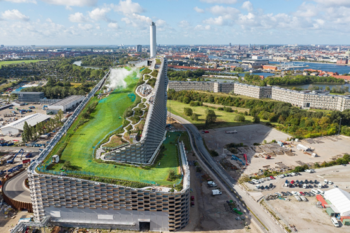Case Study: Waste-to-Energy and Social Acceptance. Copenhill WtE plant in Copenhagen
Waste-to-Energy and Social Acceptance: Copenhill WtE plant in Copenhagen
Copenhill Waste-to-Energy (WtE) represents an example of integration of WtE plants in an urban area and collaboration with the residents to achieve social acceptance in the activities developed by the WtE sector. This report describes technical and economic aspects of the Copenhill plant, and how the owners of Copenhill and the residents in the city of Copenhagen found a way to share a common area, contributing to a more sustainable city while being a profitable business case.
Copenhill redefines the concept of a WtE plant for providing a multi-functional building with room for social and industrial activities with good utilization of urban space. It is integrated into urban life with its innovative architectonic design offering a recreational area on the facility rooftop that includes an all-year skiing slope, as well as a climbing wall on the facade. From a technical point of view, Copenhill was conceived from the idea of being a WtE plant showcase that Denmark could export to the world. Therefore, it was built using the best available technology to ensure the highest environmental performance and energy efficiency all in all in the safest environment. Copenhill has two types of incomes: the gate fee for the incoming waste and revenues from selling heat to the local district heating network and electricity to the market.

Copenhill recreational area in the roof top. Source: ARC website, Ehrhorn/Hummerston
The report summaries the lessons learned from the construction of this plant:
- Integration of a WtE plant in an urban area: The right use of technology can provide a safe and sound environment where recreational activities and waste management activities can go together. Better use of the urban area, reduction in waste transportation, proximity to the district heating network and high efficiency and environmental performance are among the main features of the plant.
- Communication with locals is crucial: The closest neighbour to the plant is a residential building at 200 m distance. A continuous exchange of information between the WtE plant, residents’ representatives and business and commercial activities sharing a common urban area is crucial. Being open and involving residents and local association in an early stage of the project and keeping an open communication will make the local community feel part of it. One success factor in this case might also have been that it was the municipality themselves that were to own and operate the plant.
- Aim for higher environmental performance: Copenhill was built with the aim of complying not only to todays’ strictest national and European emission standards, but also those that might be set during the coming 30 years. Positioning SCR at the front in the process allowed to reduce NOx emissions considerably while saving energy in the process. Each furnace line has a separate flue gas-scrubbing system composed by an electronic filter that removes most of the fly ash in the smoke, and 3 scrubbers that remove hydrochloric acid, mercury, and other undesirable substances. The sulphur dioxide is removed using lime, a dust filter eliminates the last remnant of dust in the smoke and the moisture is condensed into water.
- Showcase that can be used for training: When a project is conceived as showcase for the world, it is possible to use the construction site as a place for training employees. Well-prepared professionals are then ready to export the developed technology. Such initiatives provide economic benefits for the community.
Link to the report: T36_WtE and Social Acceptance_Copnehhill WtE plant in Copenhagen
Note: This is the first of a case study compilation to explore lessons on material and energy valorisation of waste within the framework of IEA Bioenergy Task 36. The set of case studies will be published during 2021 covering social and public acceptance aspects, barriers in Waste-to-Energy (WtE) implementation, success stories for decentralized solutions,and integration of WtE within material and/or nutrient recovery. The purpose of these case studiesi s to showcase examples from which countries can get inspiration and support in implementing suitable policies and solutions in the waste/resource management and WtE sector that would facilitate their transition towards circularity.


